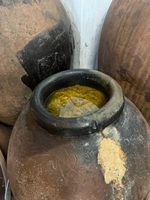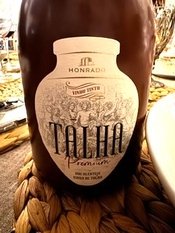Alentejo – visit as soon as possible!
If you’ve found my palate in sync with yours from reading my writings and wine reviews, that might be enough to get you to start planning and booking travel. If we’re now meeting for the first time, or you (like me) prefer to scope things out a little bit before spending your hard-earned leisure dollars, what follows here will give you a good idea of what you might be in for should your travels find their footing in seeking out the adventure that wine tourism so well provides.
A couple cursory tips before diving into the wine details: Most flights from the States will land you in either Lisbon or Porto – both beautiful cities worth spending a day or two in at a minimum. It’s a short drive north from Porto into the Vinho Verde region that offers some quite serious wine in addition to the light, fresh, inexpensive fresh whites that you may be familiar with. You can also go east along the Douro River by train or ferry boat much of the year, or you can rent a little sports car and drive out to where the Porto wine grapes grow after visiting a tasting room or two in the city.
Pro tip: Keep in mind that things are relatively close together as the entire country is about the size of Indiana, or about one fifth the size of California – Porto is about three hours north of Lisbon by train.
Lisbon is a beautiful city with plenty of things to do and see, with great public transit from the airport and the fine dining that you’d expect from any cosmopolitan center. I didn’t run across anyone who didn’t speak good English – the question “Fala Ingles? (pronounced, “Fala Inglaish”) will get you past the uniquely beautiful Portuguese language and into a conversation with some of the friendliest people you’ll ever meet.
All that said, when it comes to a place that you could easily spend a week or more for full immersion into the wine culture, Alentejo is the place to aim your attention.
Alentejo is not a city itself, but a province of Portugal that sits east of Lisbon, with the UNESCO World Heritage city of Evora at its center. Evora is a classic walled city that features Roman ruins and the Capela dos Ossos (Chapel of Bones) at the Catedral de São Francisco that are absolutely worth visiting while strolling the hilly cobblestone streets. Words carved in stone at the Capela entrance remind us that the time is now to experience what the world has to offer.

©2023 Rich Cook
Alentejo’s wines accompanied Portuguese explorers as they took to the seas in search of discovery and flourished up to being one of the last European regions to be hit by phylloxera. Post phylloxera, vineyards were replanted, more plantings were added, and regional organization started to take place, culminating in the formation of technical organizations of vineyard owners in the early 1980’s, the CVRA (the regional wine commission) in 1989 and the Confraria dos Enófilos do Alentejo, a private nonprofit support society, in 1991. The Confraria take it seriously – they even have uniforms.

©2023 Rich Cook
While Alentejo production continues to be mainly red wine, Branco (white) white varieties are experiencing a renaissance thanks to thoughtful viticulture and great winemaking in the region. Antão Vaz plays a starring role, but other varieties lend assistance – Arinto and Roupeiro in particular bring fresh acidity that plays well against Antão Vaz’ rich tropical profile, and Perrum and Diagalves can be in the mix as well. If something different in the world of wine is what you seek, you’ll certainly find it in abundance here.
From a base camp in or near Evora, you can venture out in every direction and find excellent wineries in eight different subregions to visit. Portalegre is the furthest north, with Borba, Redondo, and Reguengos just to the east, and Vidigueira, Moura and Granja-Amareleja south and southeast. There are excellent guide maps of the Rota dos Vinhos do Alentejo available online or from the regional office in Evora, and the friendly staff there will be happy to point you in a good direction for a day trip or a week-long visit.
If your schedule allows, I highly recommend traveling to Alentejo with dates that include November 11th, the date of Dia de São Martinho, or St. Martin’s Day. Besides the fall weather being much more agreeable that the broiling summer heat, the day is the traditional first taste of the vintage, and for the producers of DOC Vinho de Talha, it’s the day the Talhas are tapped for the first time. It is well worth seeing the process and tasting uber-fresh wine made by centuries old methods in a grand party atmosphere.

©Rich Cook
Over the course of a week in Alentejo I tasted several wines that I found worthy of recognition, and I’ll be posting reviews over the next several weeks – you can search our archives for the following producer names when looking for reviews: Fitapreta, Hugo Mendes, Natus, Honrado, Talha Mafia, XXVI Talhas, Cartuxa, Ravasqueira, Casa Relvas, Adega Mayor, Carmim, Aldeia de Cima, Quetzal, Esporão, and others. For now, here’s one review to whet your whistle:
Honrado, DOC Vinho de Talha (Alentejo, Portugal) Vinho Tinto  “Talha Premium” 2021 ($35): A fascinating red wine that begins with aromas of fresh cut celery that persists over soft red fruits. The celery continues to hold sway on the palate, joined by peppery stemmy notes , and muted cherry fruit that ride bright acidity through a long finish where dusty white pepper lingers. I held this bottle and tasted it daily over five days, with each day showing softening green notes and emerging cherry and strawberry fruit, with no hints of oxidation and gaining palate length each day. Intriguing and completely unique. 93
“Talha Premium” 2021 ($35): A fascinating red wine that begins with aromas of fresh cut celery that persists over soft red fruits. The celery continues to hold sway on the palate, joined by peppery stemmy notes , and muted cherry fruit that ride bright acidity through a long finish where dusty white pepper lingers. I held this bottle and tasted it daily over five days, with each day showing softening green notes and emerging cherry and strawberry fruit, with no hints of oxidation and gaining palate length each day. Intriguing and completely unique. 93
There’s so much to talk about when it comes to Alentejo that it well exceeds the space allotted here, so watch our blog space for more detail about some of the wineries and techniques as well. Meanwhile, I hope this little taste has got you salivating for more.
Boas Festas e um ótimo 2024 – Saúde!
